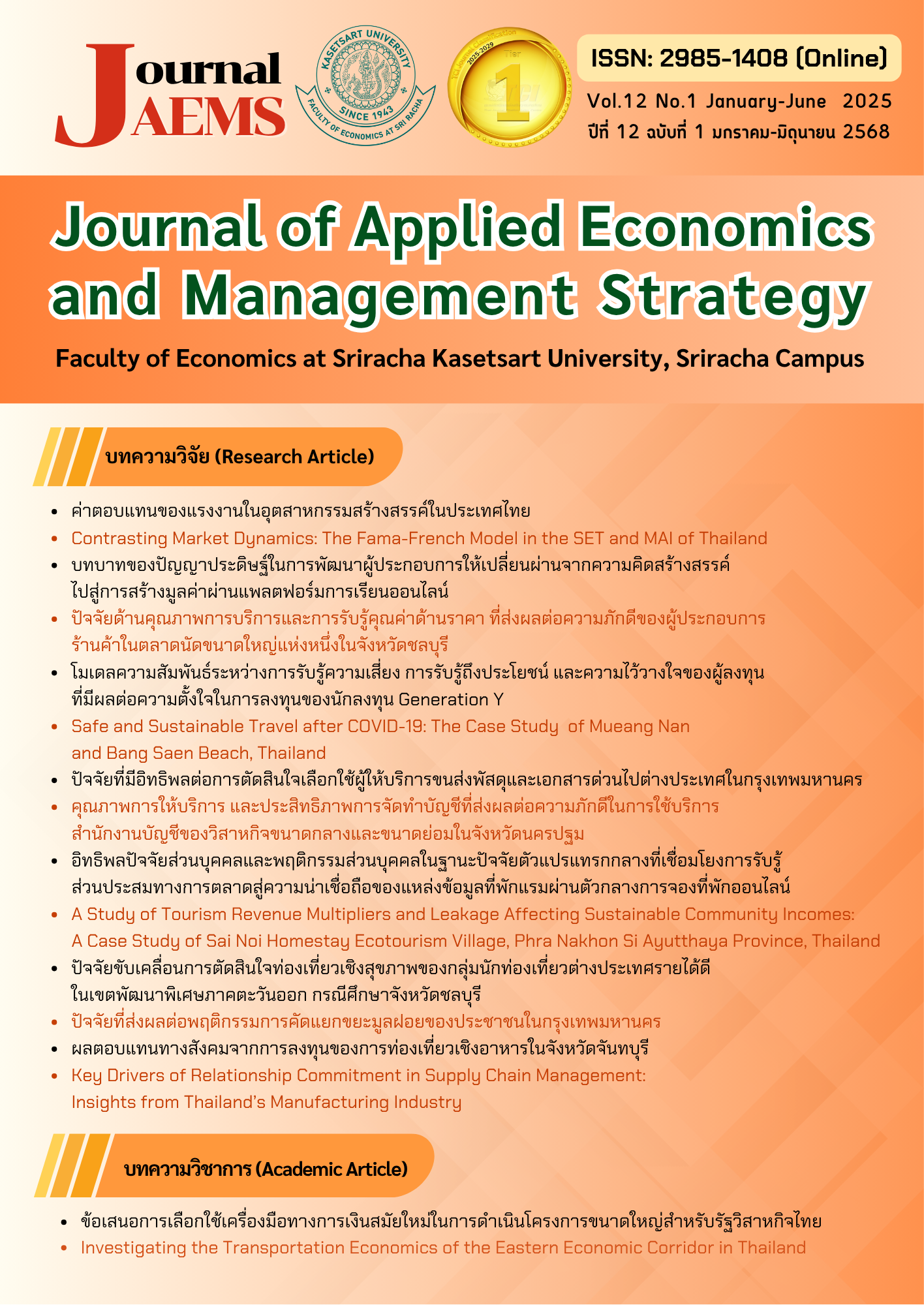ปัจจัยที่ส่งผลต่อพฤติกรรมการคัดแยกขยะมูลฝอยของประชาชนในกรุงเทพมหานคร
Main Article Content
บทคัดย่อ
การวิจัยนี้มีวัตถุประสงค์เพื่อศึกษาปัจจัยที่มีอิทธิพลต่อพฤติกรรมการคัดแยกขยะมูลฝอยของประชาชนที่อาศัยอยู่ในพื้นที่กรุงเทพมหานคร การวิจัยใช้แบบสอบถามออนไลน์รวบรวมข้อมูลจากกลุ่มตัวอย่างที่อาศัยอยู่ในกรุงเทพมหานคร ซึ่งมีอายุ 15 ปี ขึ้นไป ในช่วงเดือนพฤษภาคม - มิถุนายน พ.ศ.2567 จำนวน 421 คน ในการศึกษาได้ประยุกต์ใช้ทฤษฎีพฤติกรรมตามแผน (Theory of Planned Behavior: TPB) และใช้สถิติเชิงพรรณา ซึ่งได้แก่ค่าเฉลี่ย ค่าร้อยละ และตาราง ร่วมกับสถิติเชิงปริมาณโดยใช้การวิเคราะห์โมเดลสมการโครงสร้างแบบการวิเคราะห์เส้นทาง (Path Analysis) ผลการวิจัยพบว่า กลุ่มตัวอย่างส่วนใหญ่เป็นเพศหญิง อายุเฉลี่ย 34 ปี การศึกษาระดับปริญญาตรี เป็นพนักงานบริษัทเอกชน รายได้ส่วนบุคคลเฉลี่ย 29,482 บาท/เดือน ค่าใช้จ่ายเฉลี่ยประมาณ 17,530 บาท/เดือน จำนวนสมาชิกในครอบครัวที่มีรายได้เฉลี่ยประมาณ 3 คน ส่วนใหญ่มีความรู้เกี่ยวกับการคัดแยกขยะ และคิดว่าขยะมูลฝอยในครัวเรือนสร้างปัญหาให้กับสิ่งแวดล้อม โดยกลุ่มตัวอย่างมีความตั้งใจในการคัดแยกขยะมูลฝอย ปัจจัยที่มีอิทธิพลต่อพฤติกรรมการคัดแยกขยะมูลฝอยของกลุ่มตัวอย่าง ประกอบด้วย 1) ปัจจัยที่มีผลทางตรง ได้แก่ เขตที่อาศัย อายุ เพศ การเคยเข้าร่วมกิจกรรมทางสิ่งแวดล้อม ระดับความตั้งใจ ทัศนคติต่อพฤติกรรม การคล้อยตามกลุ่มอ้างอิง การควบคุมพฤติกรรมการรับรู้ และการปฏิเสธความรับผิดชอบในการคัดแยกขยะ 2) ปัจจัยที่มีผลทางอ้อม ได้แก่ แรงจูงใจทางเศรษฐกิจบรรทัดฐานทางศีลธรรม ความรู้เกี่ยวกับประเภทของขยะมูลฝอยและสิ่งแวดล้อม ทัศนคติทางอ้อม การคล้อยตามกลุ่มอ้างอิงทางอ้อม การศึกษา และ 3) ปัจจัยที่มีผลทางตรงและทางอ้อม ได้แก่ การควบคุมพฤติกรรมการรับรู้ทางอ้อม ดังนั้น ผู้กำหนดนโยบายควรส่งเสริมการคัดแยกขยะทุกประเภทผ่านสื่อต่างๆ หรือผ่านบุคคลที่ประชาชนเชื่อถือ และควรขจัดอุปสรรคด้านค่าใช้จ่ายที่เกี่ยวกับการคัดแยกขยะให้ลดลงด้วย
Downloads
Article Details

This work is licensed under a Creative Commons Attribution-NonCommercial-NoDerivatives 4.0 International License.
เอกสารอ้างอิง
กรมการปกครอง. (2567). ระบบสถิติทางการทะเบียน. สืบค้นเมื่อ 5 กุมภาพันธ์ 2567 จาก https://stat.bora.dopa.go.th/stat/statnew/statyear/#/FilterPageAge.
กรมควบคุมมลพิษ. (2567). ข้อมูลสถานการณ์ขยะมูลฝอยของประเทศ. สืบค้นเมื่อ 5 กุมภาพันธ์ 2567 จาก https://thaimsw.pcd.go.th/report_country.php.
ไทยพับลิก้า. (2565). วาระซ่อมกรุงเทพฯ: แผนจัดการขยะมูลฝอย กทม. 20 ปี ยังคง “ล้นเมือง” ต่อไป. สืบค้นเมื่อ 5 กุมภาพันธ์ 2567 จาก https://Thaipublica.org.
สำนักงานสถิติแห่งชาติ. (2566). รายงานสถิติจำนวนประชากรแฝงในกรุงเทพมหานคร พ.ศ.2566. สืบค้นเมื่อ 5 กุมภาพันธ์ 2567 จาก https://www.nso.go.th/nsoweb/nso/survey_detail/yS
อภินัทธ์ นิลสุข ศรัณญา เบญจกุล และมณฑา เก่งการพานิช. (2565). ปัจจัยที่มีผลต่อพฤติกรรมการจัดการขยะมูลฝอยของครัวเรือนในอำเภอทับสะแก จังหวัดประจวบคีรีขันธ์. วารสารพฤติกรรมศาสตร์เพื่อการพัฒนา, 14(2), 19-38.
Ajzen, I. (1991). The theory of planned behavior. Organizational Behavior and Human Decision Processes, 50(2), 179-211. Doi: 10.1016/0749-5978(91)90020-T.
Ajzen, I. (2019). TPB questionnaire construction. Retrieved from https://people.umass.edu/aizen/pdf/tpb.measurement.pdf
Ajzen, I. (2020). The theory of planned behavior: Frequently asked questions. Human Behavior & Emerging Technologies, 2(4), 314-424.
Bei, L.T. & Simpson, E.M. (1995). The determinants of consumer purchase decision for recycled products: an application of acquisition-transaction utility theory. In: Kardes, F.R. & Sujau, M. Eds., Advances in consumer research 22, Association for Consumer Research, Provo, 257-261.
Fikadu, D, S., Sadore, A, F., Agafari, B, G., & Doyore, F. (2022). Intention to comply with solid waste management practices among households in Butajira town, Southern Ethiopia using the theory of planned behavior. PLOS ONE, 17(7), 1-15. https://doi.org/10.1371/journal.pone.0268674
Fishbein, M., & Ajzen, I. (1975). Belief, attitude, intention and behavior: An introduction to theory and research. Reading, MA: Addison-Wesley.
Huang, D.Z.G., Yin, X., & Gong, Q. (2015). Residents’ waste separation behaviors at the source: Using SEM with the theory of planned behavior in Guangzhou, China. International Journal of Environmental Research and Public Health, 12(8), 9475- 9491. https://doi.org/10.3390/ijerph120809475
Kreitler, S. (2018). The mind-body problem: The perspective of psychology. Open Journal of Philosophy, 8, 60-75. Retrieved from http://www.scrip.org/journal/ojpp.
Oyekale, A. (2018). Determinants of households’ involvement in waste separation and collection for recycling in South Africa. Environ Dev Sustain, 20, 2343-2371. https://doi-org.portal.lib.ku.ac.th/10.1007/s10668-017-9993-x.
Oztekin, C., Teksoz, G., Pamuk, S., Sahin, E., & Kilic, D.S. (2017). Gender perspective on the factors predicting recycling behavior: Implications from the theory of planned behavior. Waste Management, 62, 290-302.
Raghu, S. J. & Rodrigues, L. L. R. (2020). Behavior aspects of solid waste management: A systematic review. J. Air Waste Manag Assoc., 70(12), 1268-1302. Doi: 10.1080/10962247.2020.1823524 Epub 2020 Oct 29.
Shuangying, Y., Tiezhan, L., Xuepeng, Q., & Weisheng, Z. (2018). Behavioral intention analysis of waste separation in China - Case study of Hangzhou using theory of planned behavior. IRSPSD International, 6(3), 63-77. http://dx.doi.org/10.14246/irspsd.6.3_63
Wu, L., Zhu, Y., & Zhai, J. (2022). Understanding waste management behavior among university students in China: Environmental knowledge, personal norms, and the theory of planned behavior. Frontiers in psychology, 12(771723), 1-14. https://doi.org/10.3389/fpsyg.2021.771723
Yamane, T. (1970). Statistic: An introductory analysis. Tokyo: John Weatherhill, Inc.
Yuan, Y., Nomura, H., Takahashi, Y., & Yabe, M. (2016). Model of Chinese household kitchen waste separation behavior: A case study in Beijing City. Sustainability 2016, 8(10), 1-28. https://doi.org/10.3390/su8101083
Zaikova, A., Deviatkin, I., Havukainen, J., Horttanainen, M., Astrup, T., Saunila, M. & Happonen, A. (2022). Factors influencing household waste separation behavior: Cases of Russia and Finland. Recycling, 7(4), 1-28. https://doi.org/10.3390/recycling7040052.
Zhang, D., Yin, X., & Gong, Q. (2015). Residents’ waste separation behaviors at the source: Using SEM with the theory of planned behavior in Guangzhou, China. International Journal of Environmental Research and Public Health, 12(8), 9475-9491. https://doi.org/10.3390/ijerph120809475
